
CHAPTER-5 || LIFE PROCESSES ||
TABLE OF CONTENT :-
1•1- What is a biological process?
1•2- Nutrition
1•3- Respiration
1•4- Transportation
1•5- Excretion
|| INTRODUCTION ||
Biotic are living beings. Abiotic are non-living beings.
The organized and well-organized structure of a living being starts deteriorating over time due to the effect of the environment. If this system breaks down, the living being will not be able to survive for longer. Hence, the body of living beings needs maintenance.
|| 1.1 || TOPIC NO.1 || What is biological process? ||
Bioprocess:- All those processes which collectively perform maintenance work. Such as respiration, digestion, excretion etc.
Energy is required for maintenance work. This energy comes into the body of the organism from outside.
(A)-Nutrition:- It is the process by which we obtain essential nutrients from food and use them. Or
the process of taking food as a source of energy and taking it inside the body is called nutrition.
(B)-Respiration :- Taking in oxygen from outside the body and using it in the decomposition of food source as per cellular requirement is called respiration.
(C)-Transportation:- Transportation means the movement of substances from one part of the body to another. It ensures that all cells get the necessary nutrients and oxygen, and harmful substances are removed from the body.
(D)- Excretion:- This is a process by which organisms expel harmful waste substances from their body. This waste is produced during chemical reactions taking place inside the body.
NOTE:- The entire surface of a unicellular organism is in contact with the environment, hence they do not require any special organ to consume food or exchange gases. But when the size of the body of an organism increases, the physical structure becomes more complex. In a multicellular organism, all the cells cannot remain in direct contact with the environment around them. Hence, simple diffusion cannot fulfill the needs of all the cells.
|| 1.2 || TOPIC NO.2 || Nutrition ||
Nutrition :- It is the process by which we obtain and use essential nutrients from food.
Living beings need energy to survive and to carry out various metabolic activities in the body. We get this energy from food.
Metabolism:- It is the sum of all the chemical reactions occurring in the body of an organism which are necessary for survival.
NOTE:- Enzymes- These are proteins that help speed up chemical reactions in the body. Enzymes that help in digestion include amylase, pepsin and trypsin etc. Enzymes are also called biocatalysts.
Nutrients:- There are mainly five nutrients in food.
1-Carbohydrates
2-Fats
3-Protein
4-Vitamins
5-Minerals
(1) Carbohydrates:- These are made by the combination of carbon, hydrogen and oxygen. These are of two types. Simple carbohydrates such as glucose, fructose, lactose. In simple form these are found in sugarcane, beetroot, dates etc. Complex carbohydrates are found in the form of starch in potatoes, rice, corn, tapioca etc.
(2) Fat:- Fat is formed by the combination of carbon, hydrogen and oxygen, but the amount of oxygen in it is relatively less. We get fat from animals in the form of butter, cheese, milk and ghee. Coconut, almond, peanut, mustard, oilseeds etc. are its plant sources.
(3) Protein:- Carbon, hydrogen, oxygen and nitrogen take part in the formation of protein. Protein molecule is made up of many amino acids. The sources of protein in animals are meat, fish, milk, eggs and cheese etc., whereas in the plant kingdom, protein is obtained from pulses, wheat, peanuts, almonds etc.
(4) Vitamins:- These are complex organic substances, their deficiency causes deficiency diseases.
There are mainly two types of vitamins:-
(1)- Water soluble vitamins- B, C
(2)- Fat soluble vitamins- A, D, E, K
(5) Mineral Salts:- Inorganic mineral salts are essential for many metabolic activities. They are required for the formation of calcium and phosphorus for teeth and bones.
(1.2.1)- Autotrophic Nutrition:- Autotrophs like plants convert substances taken from outside like carbon dioxide and water into carbohydrates in the presence of sunlight and chlorophyll. Carbohydrates are used to provide energy to the plants. These carbohydrates are not used immediately, they are stored in the form of starch.
Starch:- It is a complex carbohydrate (polysaccharide) made up of a chain of glucose molecules. It is produced by plants for energy storage.
What actually happens in the process of photosynthesis:-
Light energy is absorbed by chlorophyll. By converting light energy into chemical energy, water (H2O) is decomposed into hydrogen and oxygen. Carbon dioxide (CO2) is reduced into carbohydrates.

Reduction:- A chemical process in which an electron is added to an element or compound or hydrogen is added or oxygen is lost. It is defined as the gain of electrons.
Oxidation:- A chemical process in which electrons are lost by a substance or oxygen is added to a substance or hydrogen is removed. Example: Rusting of iron, burning of fuel and respiration are all oxidation processes.
When we observe the cross section of a leaf through a microscope, we see green dots in some cells. These green dots are organelles called chloroplasts, which contain chlorophyll.
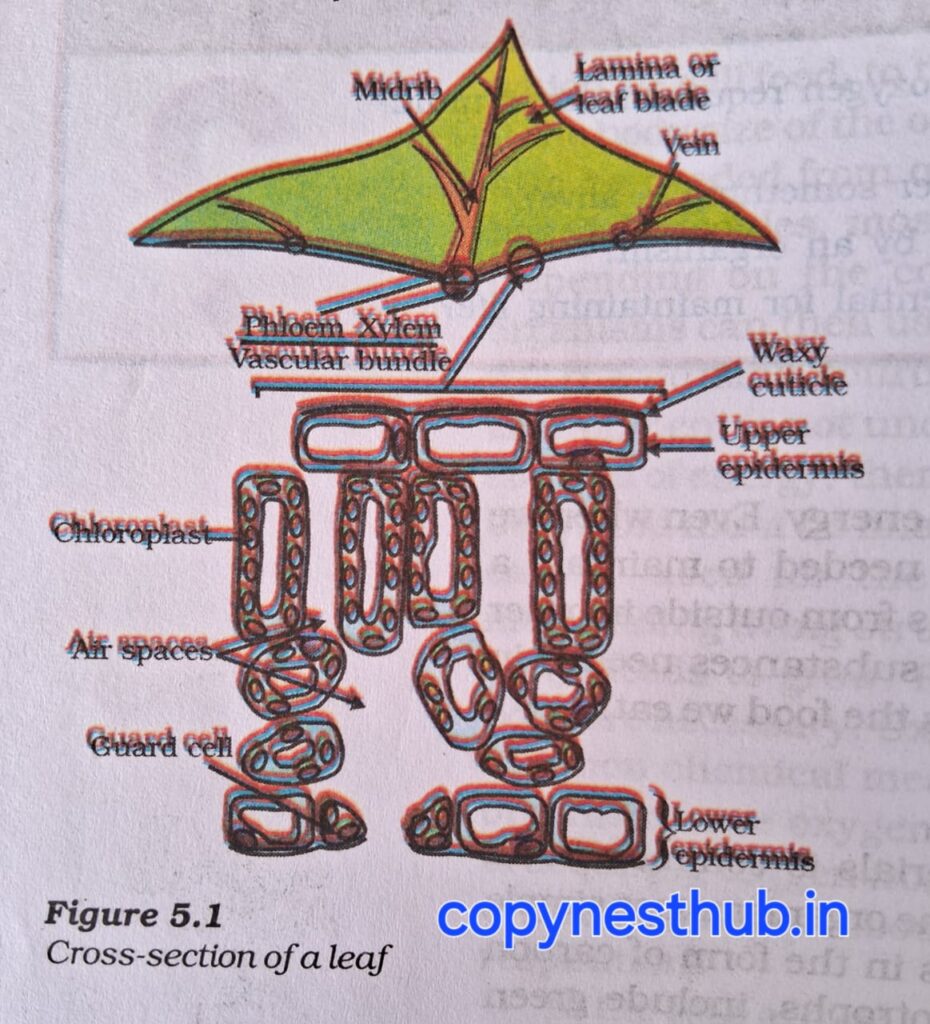
Longitudinal section:- Obtained when an object is cut parallel to its length.
Transverse section:- Obtained when the object is cut perpendicular to its length.
Stomata :- Tiny pores are found on the surface of the leaf.
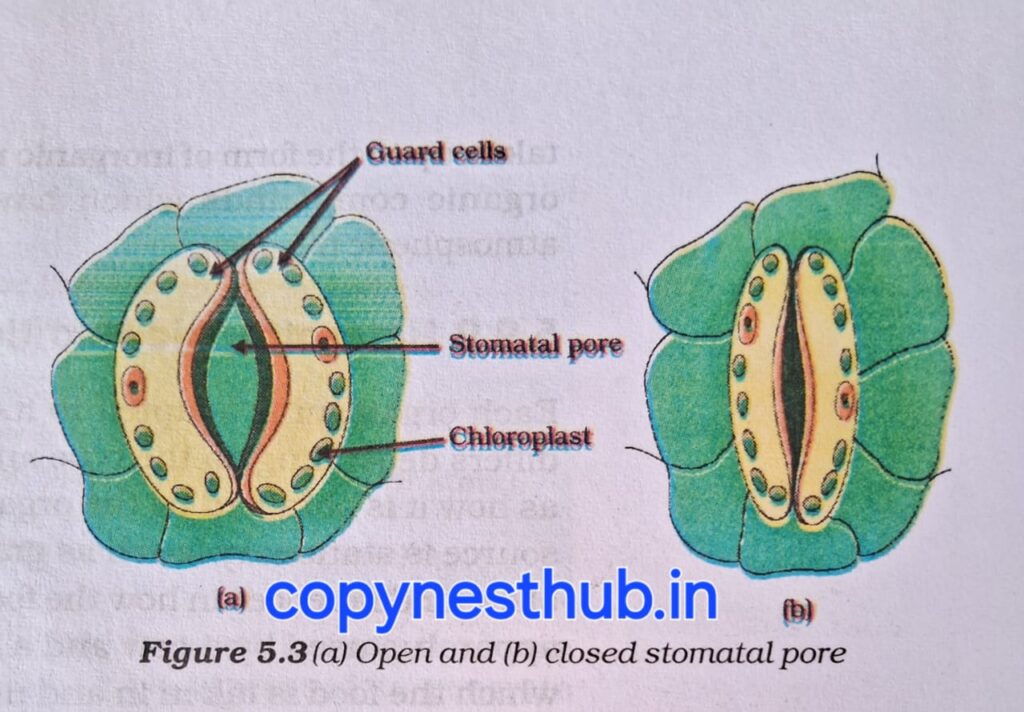
Most of the exchange of gases for photosynthesis takes place through stomatal pores. Water is also lost through these pores, so when carbon dioxide is not needed for photosynthesis, the plant closes these pores. The opening and closing of pores is a function of guard cells. When water enters the guard cells, they swell and the stomatal pore opens, similarly when the guard cells contract, the pore closes.
The water required for photosynthesis is supplied by the roots by absorbing water present in the soil. Other substances like nitrogen, phosphorus, iron and magnesium are also taken from the soil. Nitrogen is an essential element, which is used in the synthesis of proteins and other compounds.
Plants absorb nitrogen mainly in two forms:-
(1)-Nitrate (NO3-):- This is the form of nitrogen most commonly used by plants.
(2)-Ammonium (NH4+):- This form is also absorbed by plants, but in smaller amounts than nitrate.
In the soil, these ions are present and plants absorb them through their roots.
In some cases, plants can also obtain nitrogen from organic substances such as amino acids.
Absorption of Nitrogen:- Plants absorb nitrate and ammonium ions through their roots, which absorb these nutrients along with water from the soil.
Use of Nitrogen:- Once absorbed, nitrogen is used by plants for the synthesis of proteins, DNA, RNA and other important biomolecules.
(1.2.2) – Heterotrophic nutrition:- Every organism is adapted to its environment. Method of nutrition can be of different types depending upon the form and availability of food.
Organisms have many methods of consuming and using food. Some organisms break down the food material outside the body and then absorb it. Fungi such as mold, yeast and mushrooms are examples of this. Other organisms ingest the entire food material and their digestion takes place inside the body.
Some other organisms obtain nutrition from plants and animals without killing them. This nutrition technique is used by dodder, orchids, ticks, lice, leeches and tapeworms.
(1.2.3)- How organisms nourish themselves:- The method of ingestion of food and its intake varies and the digestive system is also different in different organisms. In a unicellular organism food is taken from the entire surface but as the complexity of the organism increases the organs performing different functions become specialised. For example amoeba takes food with the help of temporary finger like extensions from the cellular surface. These extensions surround the food particles and fuse to form a food vacuole. Inside the food vacuole the complex substance is broken down into simpler substances and these are diffused into the cytoplasm. The remaining undigested material moves towards the cell surface and is expelled out of the body.
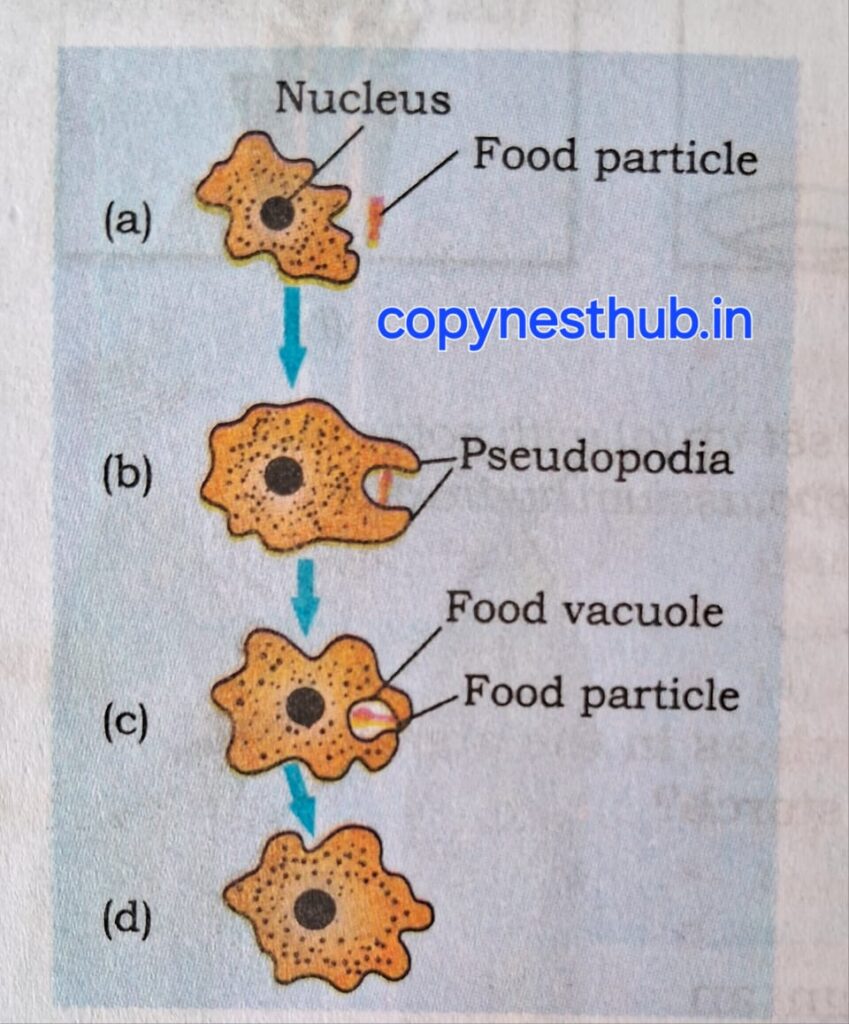
Paramecium is also a unicellular organism. Its cells have a definite shape and food is consumed from a particular place only.
(1.2.4)- Nutrition in Humans:- The alimentary canal is basically a long tube extending from the mouth to the anus.
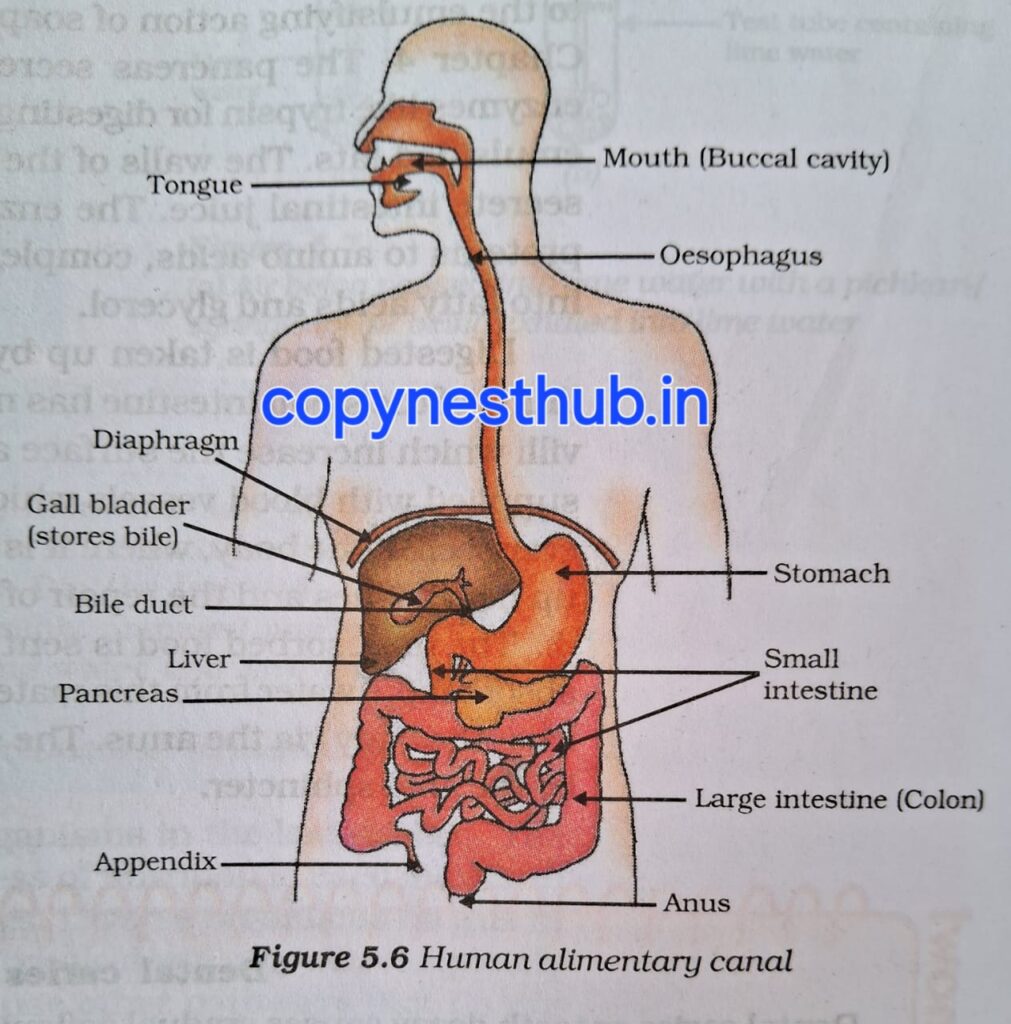
Naturally, food has to go through a process in which it gets transformed into smaller particles.
Whenever we eat something of our choice, our mouth starts watering. Actually it is not just water, it is a juice secreted by the salivary gland, which is called saliva. Saliva also contains an enzyme, which is called salivary amylase. It breaks down starch into sugar. While chewing food, the muscular tongue mixes the food completely with saliva.
Glucose:- Also called sugar, it is a type of carbohydrate that is found naturally in foods and is also added to foods and beverages. It is a source of energy and can be classified into monosaccharides (such as glucose, fructose) and disaccharides (such as sucrose, lactose).
Types of sugar: –
(1)-Glucose:- It is a simple sugar that is a primary source of energy and is found in fruits, vegetables and honey.
(2)-Fructose:- This is another simple sugar found in fruits, vegetables and honey.
(3)-Sucrose: – Also known as table sugar, it is a disaccharide composed of glucose and fructose and is obtained from sugarcane and sugar beets.
(4)-Lactose:- It is a sugar found in milk, which is composed of glucose and galactose.
Food is taken from the mouth to the stomach through the oesophagus. The stomach is a large organ which expands when food comes in. The muscular wall of the stomach helps in mixing the food with other digestive juices.
These digestive functions are performed by the gastric glands present in the wall of the stomach. They secrete hydrochloric acid, a protein digesting enzyme called pepsin and mucus. Hydrochloric acid forms an acidic medium, which helps in the action of the enzyme pepsin. Under similar conditions, mucus protects the inner lining of the stomach from acid.
Gastric juice:- also known as gastric juice, is a digestive juice produced in the stomach. It is secreted by the gastric glands present in the walls of the stomach. Gastric juice mainly consists of hydrochloric acid (HCl), pepsin and mucus.
(1)-Hydrochloric Acid (HCl): –
Makes food acidic, which helps to activate pepsin and kill bacteria present in the food.
(2)-Pepsin: –
It is an enzyme that breaks down proteins into smaller peptides.
(3)-Mucus: –
It protects the stomach lining from hydrochloric acid and prevents damage to the stomach during digestion.
Food from the stomach now enters the small intestine. The small intestine is the longest part of the alimentary canal. Grass-eating herbivores require a long small intestine to digest cellulose. Digestion of meat is easy, so carnivores like tigers have a short small intestine.
The small intestine is the site of complete digestion of carbohydrates, proteins and fats. For this purpose it receives secretions from the liver and pancreas. The food coming from the stomach is acidic and is made alkaline by the action of pancreatic enzymes. Bile juice secreted from the liver performs this function.
The pancreas secretes pancreatic juice, which contains trypsin enzyme for protein digestion and lipase enzyme for fat digestion. There are glands in the wall of the small intestine, which secrete intestinal juice. The enzymes present in it finally convert proteins into amino acids, complex carbohydrates into glucose and fats into fatty acids and glycerol.
The intestinal wall absorbs the digested food. The small intestine has many finger-like projections on its inner layer, called villi. These increase the surface area of absorption. The villi have an abundance of blood vessels, which absorb the food and transport it to every cell of the body. Here it is used to obtain energy, build new tissues and repair old tissues.
The undigested food is passed to the large intestine, where it absorbs water through the digestive system and the rest of the waste material is expelled from the body through the digestive system.
|| 1.3 || TOPIC NO.3 || Respiration ||
The food substances that are ingested for the nutrition process are used by the cells to provide energy for various life processes. Different organisms do this by different methods:-
Some organisms use oxygen to break down glucose completely into carbon dioxide and water.
Some organisms use another pathway that does not use oxygen.
Anaerobic respiration :- This process takes place in the absence of air.
Aerobic respiration :- This process takes place in the presence of air.
The energy release in aerobic respiration is much greater than in anaerobic respiration.

The energy released by cellular respiration is immediately used to synthesize a molecule called ATP, which is used as fuel for other cell functions. The breakdown of ATP produces a certain amount of energy, which drives endothermic reactions within the cell.
ATP can be used in the cell for many activities like muscle contraction, protein synthesis, transmission of nerve impulses, etc.
Plants exchange gases through stomata. At night, when no photosynthesis is taking place, the main exchange process is the release of carbon dioxide. During the day, the carbon dioxide released during respiration is used in photosynthesis, so no carbon dioxide is released. At this time, the release of oxygen is the main event.
Animals evolved different types of organs to take in oxygen from the environment and get rid of the carbon dioxide produced. Terrestrial animals take in atmospheric oxygen, but animals that live in water need to use oxygen dissolved in water.
Organisms that live in water use oxygen dissolved in water, because the amount of oxygen dissolved in water is much less than the amount of oxygen in the air, so the breathing rate in aquatic organisms is faster than that of terrestrial organisms. Fish take water through their mouths and force it to the gills, where the dissolved oxygen is taken up by the blood.
In humans, air enters the body through the nostrils. The air entering through the nostrils is filtered by the fine hairs present in the passage, due to which the air entering the body is free from dust and other impurities. There is a layer of mucus in this passage, which helps in this process. From here, the air flows into the lungs through the throat.
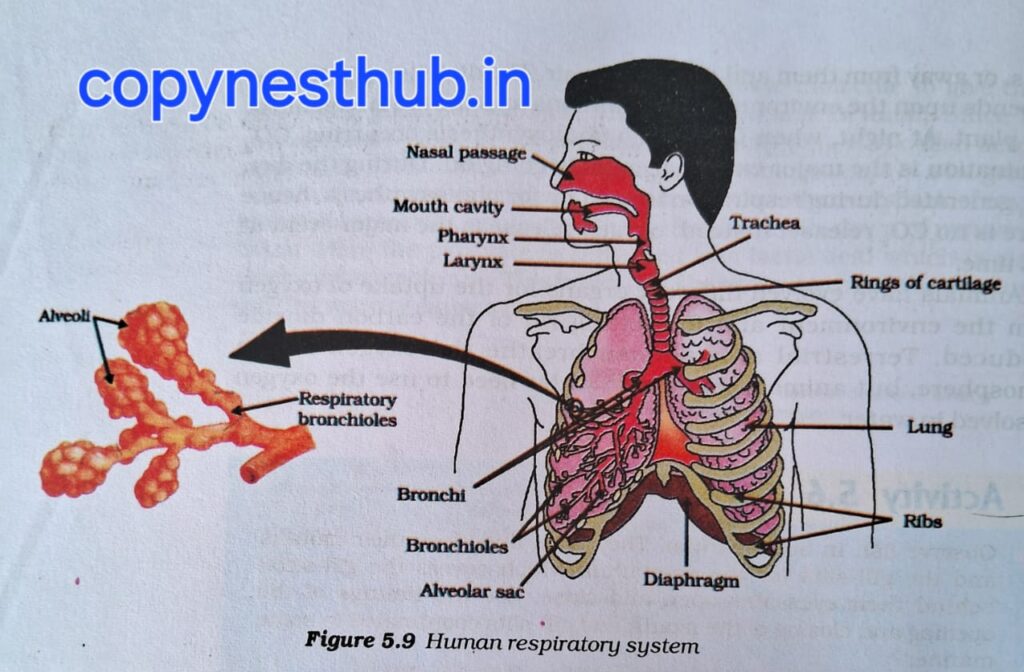
Inside the lungs the passages divide into smaller and smaller tubes that eventually form balloon-like structures called alveoli. The alveoli provide a surface through which gas exchange can take place. The walls of the alveoli contain a network of blood vessels. When we breathe in, our ribs rise and our diaphragm flattens, causing the chest cavity to enlarge. This causes air to be sucked into the lungs and fill the expanded alveoli. Blood brings carbon dioxide from the rest of the body to be released into the alveoli. The blood in the alveolar blood vessels takes up oxygen from the alveolar air and carries it to all the cells of the body. As air is drawn in and out during the breathing cycle, the lungs always retain a residual volume of air, allowing enough time for the absorption of oxygen and the release of carbon dioxide.
As the body size of animals increases, diffusion pressure alone is insufficient to transport oxygen to all parts of the body. Its efficiency decreases. Respiratory pigments take up oxygen from the air in the lungs and transport it to those tissues which are deficient in oxygen. In humans, the respiratory pigment is haemoglobin, which has a high affinity for oxygen. This pigment is found in red blood cells (RBC). Carbon dioxide is more soluble in water and hence it is transported in dissolved form in our blood.
|| 1.4 || TOPIC NO.4 || Transportation ||
(1.4.1) – Transportation in Humans:- Blood carries food, oxygen and waste material through our body. Blood is a fluid connective tissue. Blood contains a fluid medium called plasma in which cells are suspended. Plasma carries food, carbon dioxide and nitrogenous waste material in dissolved form. Oxygen is carried by red blood cells. Many other substances such as salts are also carried by blood. So we need a pumping system to push blood around the organs, a circuit of tubes to send blood to all the tissues and a system to ensure that if any breakage occurs in this circuit, it can be repaired.
Heart:- Heart is a muscular organ, which is the size of our fist. Blood has to carry both oxygen and carbon dioxide, so the heart is divided into many chambers to prevent oxygen rich blood from mixing with carbon dioxide rich blood. Carbon dioxide rich blood has to go to the lungs to release carbon dioxide and oxygenated blood has to be brought back from the lungs to the heart. This oxygen rich blood is then pumped to the rest of the body.
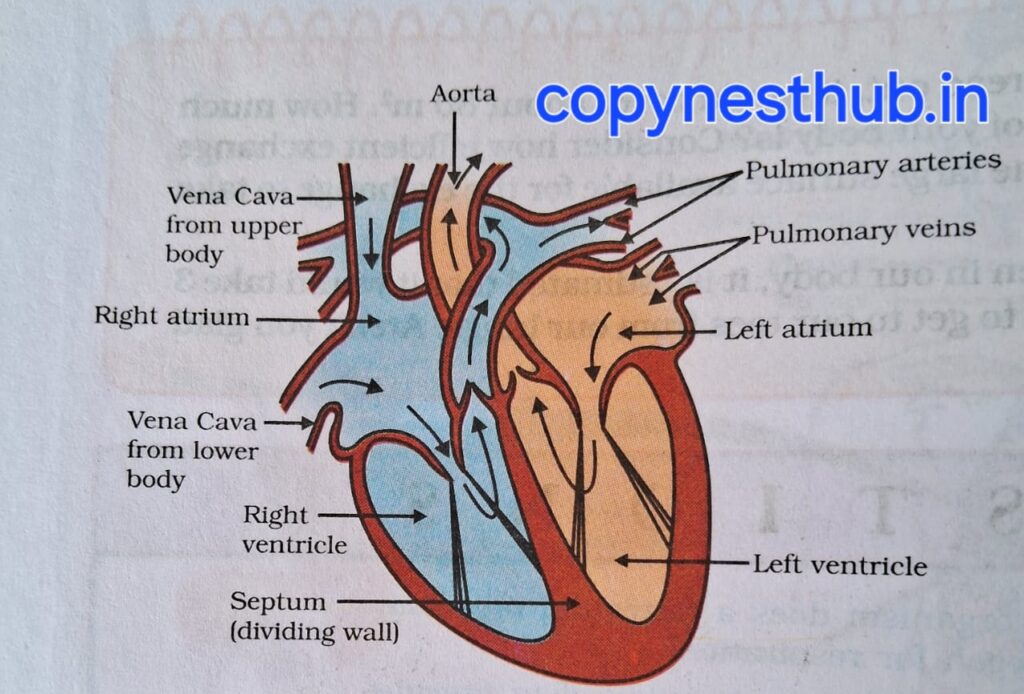
Oxygen-rich blood comes from the lungs to the left atrium, a chamber on the left side of the heart. The left atrium remains relaxed while collecting this blood. It contracts when the next chamber, the left ventricle, expands, thereby transferring blood into it. When the muscular left ventricle contracts in its turn, the blood is pumped out to the body.
As the upper right chamber, the right atrium, expands, it draws in deoxygenated blood from the body. As the right atrium contracts, the corresponding chamber below, the right ventricle, expands. This transfers the blood to the right ventricle, which in turn pumps the blood to the lungs for oxygenation.
When the atrium or ventricle contracts, the valve prevents blood flow in the reverse direction.
NOTE:- The muscular wall of the ventricle is thicker than that of the atrium, because the ventricle has to send blood to the entire body.
Oxygen enters the blood in the lungs:- The right and left partitions of the heart are helpful in preventing the mixing of oxygenated and deoxygenated blood.
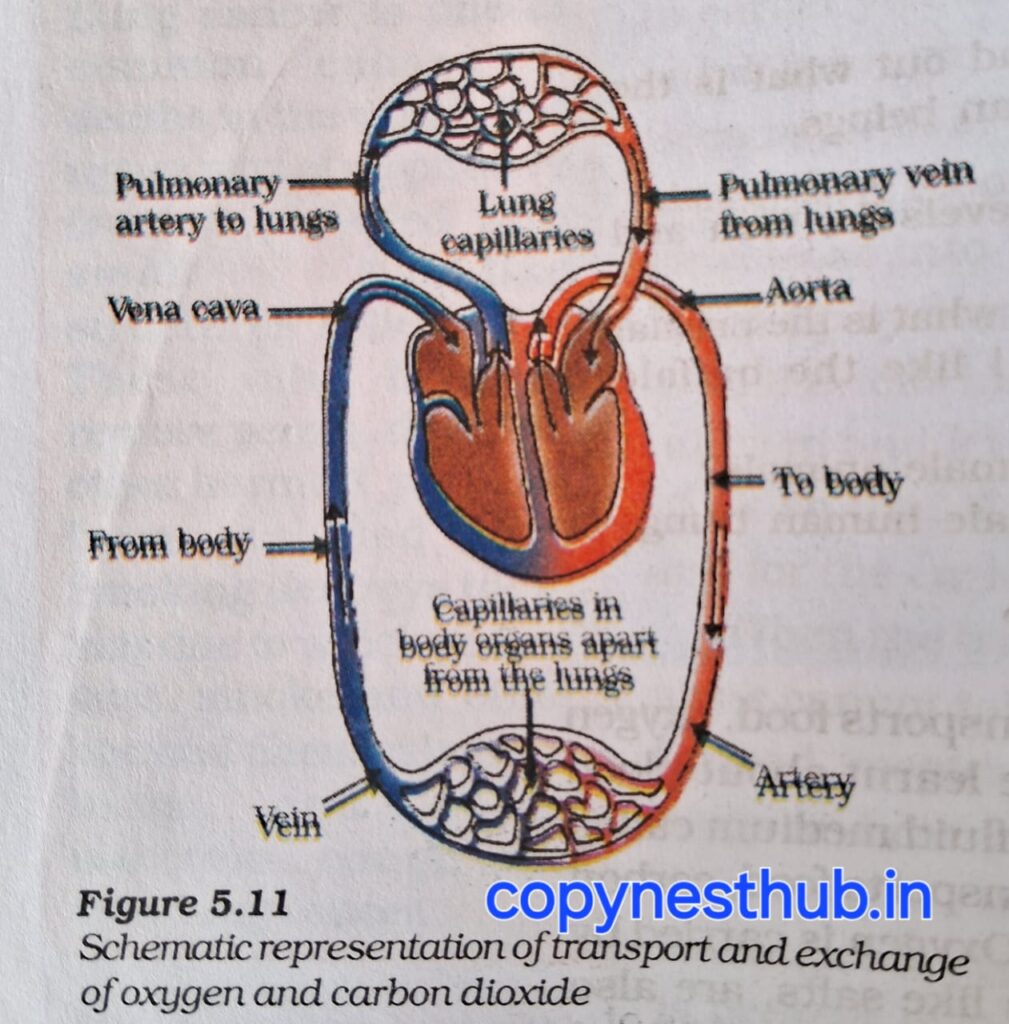
Humans have a four chambered heart. Animals like water, land animals or many reptiles have a three chambered heart. On the other hand, fish have only two chambers in their heart.
Double circulation:- Double circulation means that blood passes through the heart twice, efficiently transporting oxygen and nutrients through the body.
Humans and other mammals and birds use a double circulatory system.
This happens in two ways:-
(1)- Pulmonary circulation (through the lungs)
(2)- Systemic circulation (through the rest of the body)
Two main routes of double circulation:-
(1)-Pulmonary circulation:
It begins in the right side of the heart. Deoxygenated blood travels to the lungs through the pulmonary artery, where it becomes oxygenated. Oxygenated blood returns to the left side of the heart through the pulmonary vein.
(2)-Systemic circulation:
It begins in the left side of the heart. Oxygenated blood travels through the aorta to various organs and tissues of the body, where it releases oxygen and nutrients. Deoxygenated blood returns to the right side of the heart through the veins.
Importance of double circulation:-
It ensures that the body always receives blood rich in oxygen and nutrients, which is necessary for energy production and body functions.
It keeps pure and impure blood separate, making oxygen supply to the body more efficient.
Arteries are blood vessels that carry blood from the heart to various parts of the body. Arteries have thick and flexible walls because blood leaves the heart with high pressure. Ventricles collect blood from various organs and bring it back to the heart. They do not require thick walls because blood has pressure but they have valves to let blood flow in only one direction.
On reaching an organ or tissue, the artery divides into smaller vessels in which blood has contact with all the cells.
Blood loss in this vascular system should naturally be minimal. In addition, bleeding will cause a drop in pressure, which will reduce the efficiency of the pumping system. To prevent this, the blood contains platelet cells, which travel throughout the body and form a clot at the site of bleeding to block the passage.
Lymph:- It is a colorless fluid that flows through the lymphatic system. It helps cleanse the body by collecting fluids, proteins, and fats from body tissues, delivering nutrients, fighting infections, and removing waste.
Importance of Lymph:-
The lymphatic system, which includes lymph, lymph vessels, and lymph glands, performs several important functions for the body:
(1)-Maintaining fluid balance:
Lymph collects excess fluid from the tissues and returns it to the bloodstream, helping to maintain fluid balance in the body.
(2)-Transport of nutrients:
Lymph helps deliver nutrients and fats to tissues and cells
(3)-Fighting infection:
Lymph contains lymphocytes (a type of white blood cell) that play an important role in fighting infections.
(4)-Removal of waste materials:
Lymph collects harmful substances, such as bacteria, viruses and damaged cells, and helps remove them from the body.
(5)-Fat absorption:
Lymph helps absorb fats from the digestive tract and transport them into the bloodstream.
(6)-Immunity:
The lymphatic system, which includes the lymph glands, is an important part of the body’s immune system, which helps fight infections and disease.
Lymph and the lymphatic system are essential to the body’s health and wellbeing, playing vital roles in maintaining fluid balance, transporting nutrients, fighting infections, and removing waste materials.
(1.4.2) – Transport in plants:- Soil is the nearest and most abundant source of nitrogen, phosphorus and other mineral salts for plants, so these substances are absorbed by the roots which are in contact with the soil.
Plants require less energy and can use relatively slow transport systems.
The xylem transports water and mineral salts obtained from the soil, while the phloem transports photosynthesis products from the leaves to other parts of the plant.
Transpiration :- The loss of water in the form of vapour from a plant is called transpiration.
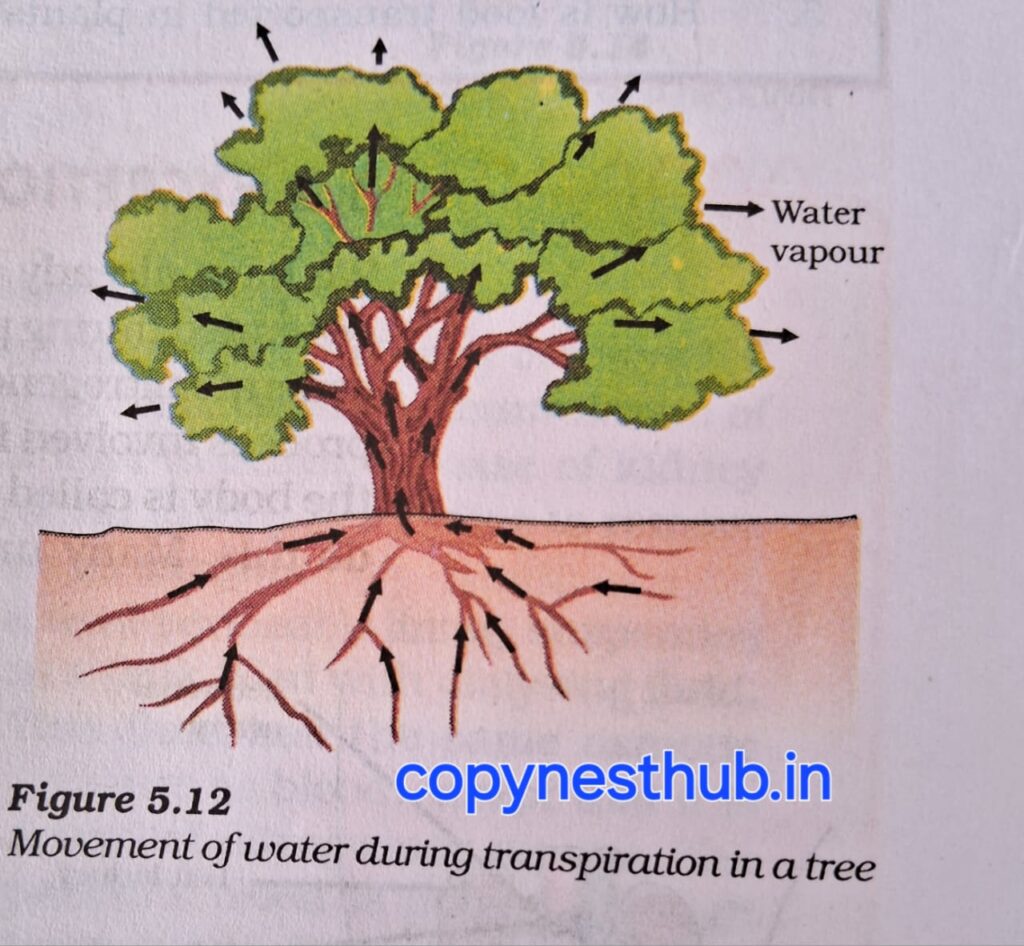
Transpiration also helps in temperature regulation.
|| 1.5 || TOPIC NO.5 || Excretion ||
Excretion :- The biological process in which harmful metabolic waste materials are removed is called excretion.
Different animals use different strategies for this. Complex multicellular organisms use specialized organs to accomplish this task.
(1.5.1)- Excretion in humans:-
The excretory system of humans consists of a pair of kidneys, a ureter, a urinary bladder and a urethra. The kidneys are located in the abdomen on both sides of the spinal cord. After the urine is formed in the kidney, it passes through the ureter and reaches the urinary bladder, where it collects until it is released through the urethra.
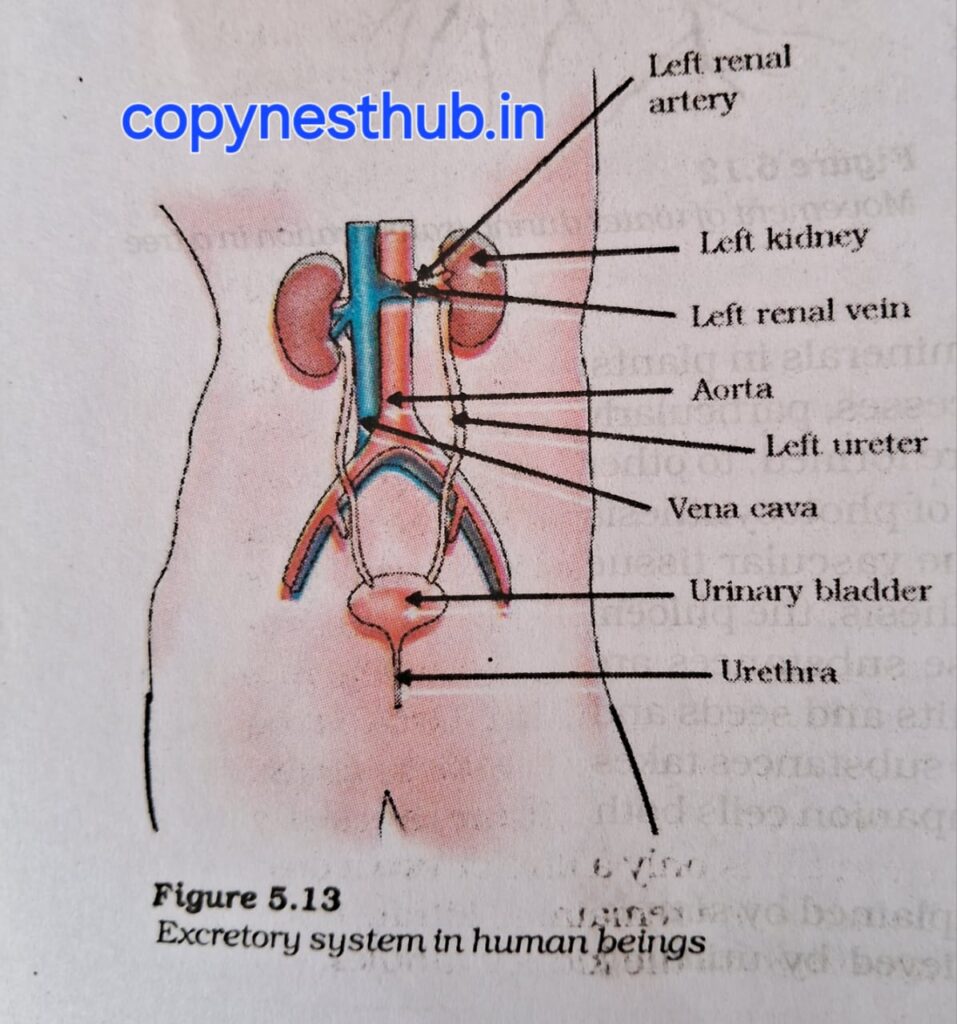
Each kidney contains many such filtration units, called nephrons. These are closely packed together.
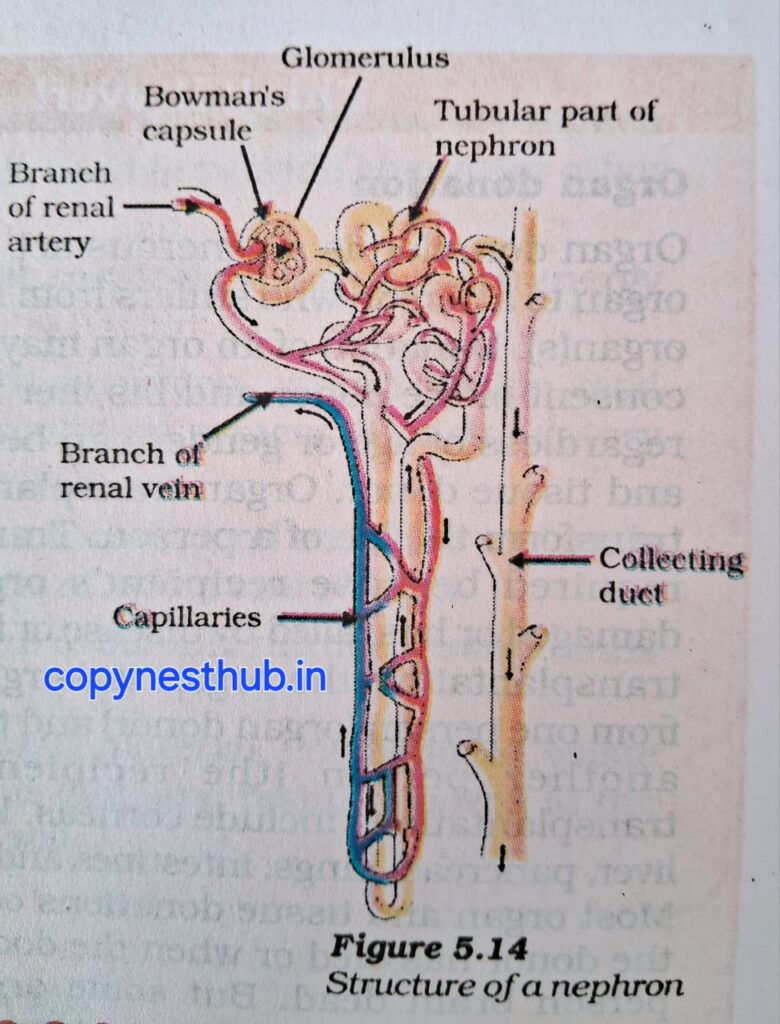
Urine produced in each kidney enters a long tube, the ureter, which connects the kidney to the bladder. Urine is stored in the bladder until the pressure of the expanding bladder forces it out through the urethra. The bladder is muscular and thus under nervous control, as a result we can usually control the flow of urine.
(1.5.2)- Excretion in plants:-
Plants use completely different methods for excretion from animals. Oxygen produced in photosynthesis can also be converted into a waste product.
Many tissues in plants are made up of dead cells and they can also lose parts, such as leaves. Many plant waste products are stored in the cellular villi. Waste products are also stored in leaves that fall from the plant. Other waste products are stored as resins and gums, especially in older xylem. Plants also excrete some waste products into the surrounding soil.
THANKS FOR READING…
- ENERGY FLOW IN ECOSYSTEM
- OZONE LAYER AND HOW IT IS GETTING DEPLETED?
- UNIT
- FOOD CHAIN
- BRANCHES OF SCIENCE